Access Agilent eNewsletter, March 2014
>> Update My Profile | Subscribe to Access Agilent | Article Directory

Navigate your way to the best GPC/SEC column
By Stephen Luke
Agilent Product Manager, GPC Columns
There are many columns available for the analysis of polymers by GPC/SEC, and selecting the appropriate column for your analysis is essential to maximizing both results and productivity. An excellent way to begin your search is with Agilent’s LC Column and Sample Prep Navigator, a web-based tool that allows you to easily choose the best LC column for your needs. The Navigator helps you narrow your search criteria by asking you to choose from a short list of options. Once you select an option, the Navigator makes specific recommendations based on your input. Targeted results are achieved by using any of four search options:

- Your own column or sample prep method
- Your own method parameters
- Compound-specific references
- USP methods
The Navigator has recently become even more valuable because it has now been revised to include Agilent’s range of GPC and SEC columns. Now GPC/SEC users can select from any one of the options listed above to review specific column recommendations for GPC.
The resulting recommendations provide an entry point for exploring the full range of Agilent GPC and SEC columns. Initial search results often lead you to Agilent PL aquagel-OH MIXED column for aqueous eluents, the Agilent PLgel MIXED column for organic eluents, or the Agilent PolarGel column for polar eluents. Here’s why these columns are a good place to start your search.
PL aquagel-OH MIXED provides a stable matrix for aqueous eluents
The Agilent PL aquagel-OH MIXED-M 8 µm column is the place to start if your analyte is water-soluble and you don’t know its molecular weight range. Part of the Agilent PL aquagel-OH series, this column provides a chemically and physically stable matrix for reliable aqueous SEC separations. These columns are packed with macroporous copolymer beads with extremely hydrophilic polyhydroxyl functionality. The ‘neutral’ surface – combined with the ability to operate across a wide range of eluent conditions – gives you high performance analysis of compounds with neutral, ionic, and hydrophobic moieties, either alone or in combination. PL aquagel-OH is available for analytical and preparative applications, has a pH range of 2 to 10, is compatible with aqueous solvent (up to 50% methanol) and mechanically stable up to 140 bar, and has a low operating pressure.
Agilent PL aquagel-OH MIXED 8 µm columns simplify column selection and provide you with a versatile analytical system by offering high resolution over a very wide range of molecular weights. Typical applications include heparin, gum, polyacrylic acid, polyacrylamide, pectin, and dextran.
PLgel 5 µm MIXED provides fast run times with organic eluents
The Agilent PLgel MIXED-C 5 µm column is designed for the analysis of organic-soluble polymers up to 2 million MW, especially those containing small additives. It is also a good starting point for compounds when you don’t know the molecular weight range. PLgel gives you fast run times to improve productivity, and excellent solvent compatibility to maximize column utility. The linear calibration curve with this column ensures consistent resolution across the molecular weight range. Agilent PLgel columns are ideal for the analysis of polystyrenes, polyurethanes, polycarbonates, and polysiloxanes.
PolarGel-M provides superior resolution with polar eluents
Agilent’s PolarGel-M GPC/SEC columns analyze many polymers in polar solvents. These columns have an optimized pore size distribution and particle size for superior resolution, with a mixed-bed technology that simplifies column selection. The design of Agilent’s PolarGel-M GPC/SEC column helps to prevent sample and stationary phase interactions thus enhancing the accuracy of molecular weight measurements. Phenol formaldehyde resins and lignins are typical applications.
Get more out of your GPC analysis and calibrate with confidence
You can use Agilent standards, such as EasiVial or EasiCal, to calibrate your columns and get the most out of your GPC analysis. Agilent makes it easy with Calibrating GPC Columns – A Guide to Best Practice, helping you make the most from the calibration curves you use in your method development by including many tips and tricks that you can incorporate into your standard operating procedures.
Expand your GPC/SEC knowledge and improve your results
Agilent offers a comprehensive portfolio of GPC/SEC instruments, columns, and calibrants for high performance separations based on molecular size in solution. Agilent also offers free access to application compendia, primers, and selection guides to help you find the best products for your particular needs and maximize their effectiveness. What’s more, our Parts Finder tool makes it easy for you to quickly locate a particular replacement part or consumable supply. Just download the Agilent Parts Finder Tool, click an instrument model, locate the part, add that part to your parts list, and print the list for easy ordering.
So get familiar with the Agilent LC Column and Sample Prep Navigator, Parts Finder Tool, and our expansive online resources that are ready to help you navigate your way to success.
>> Update My Profile | Subscribe to Access Agilent | Article Directory